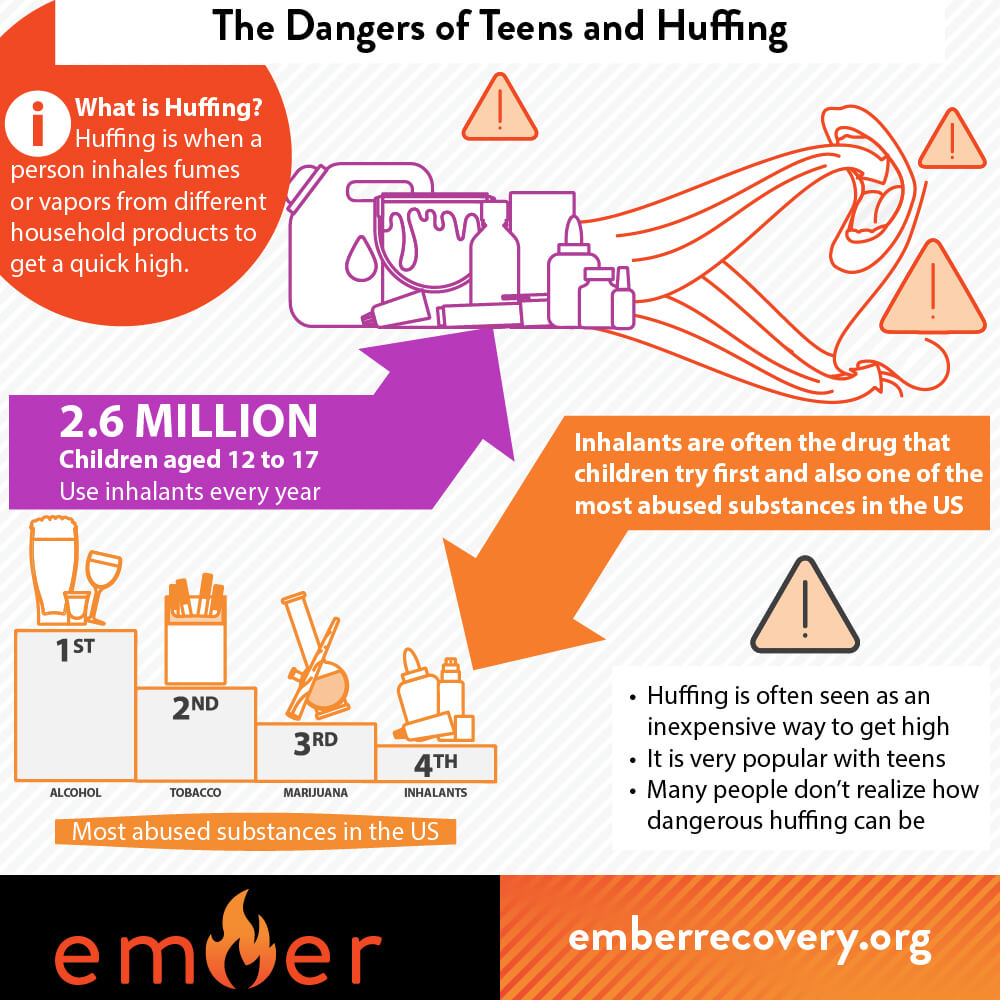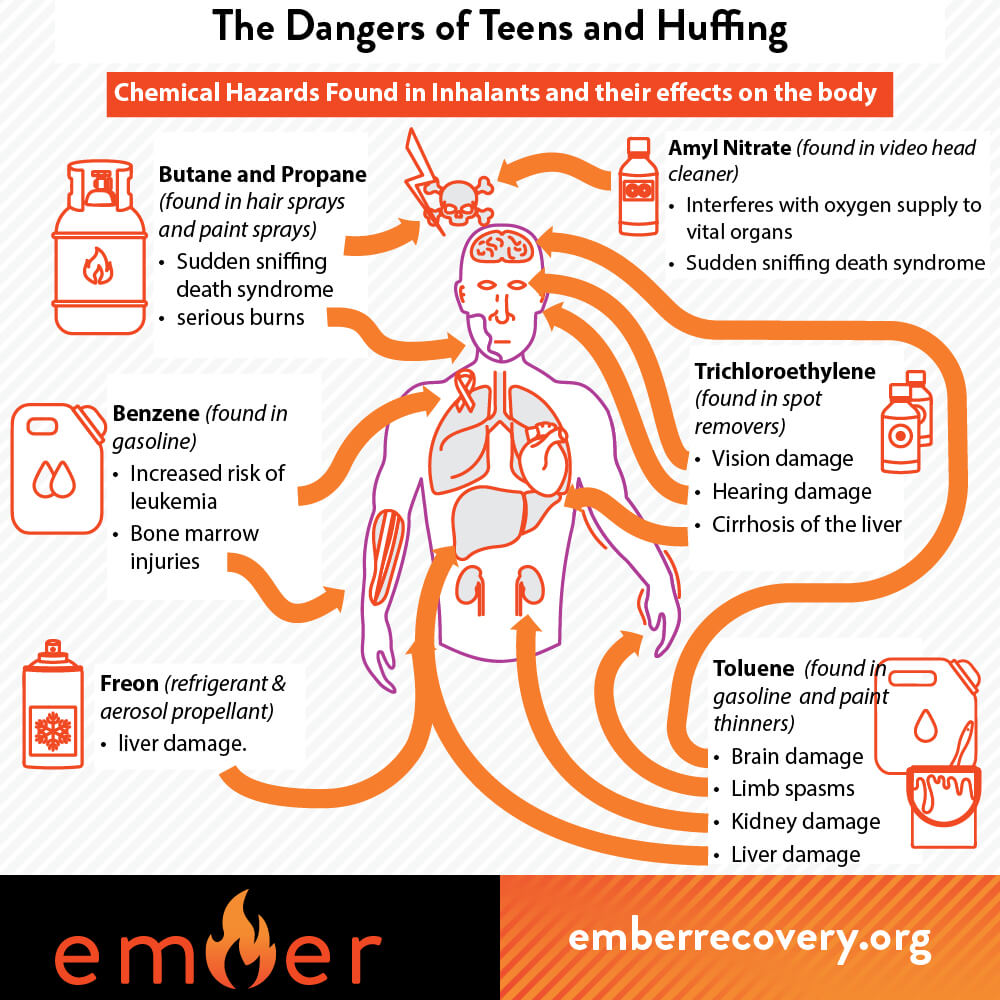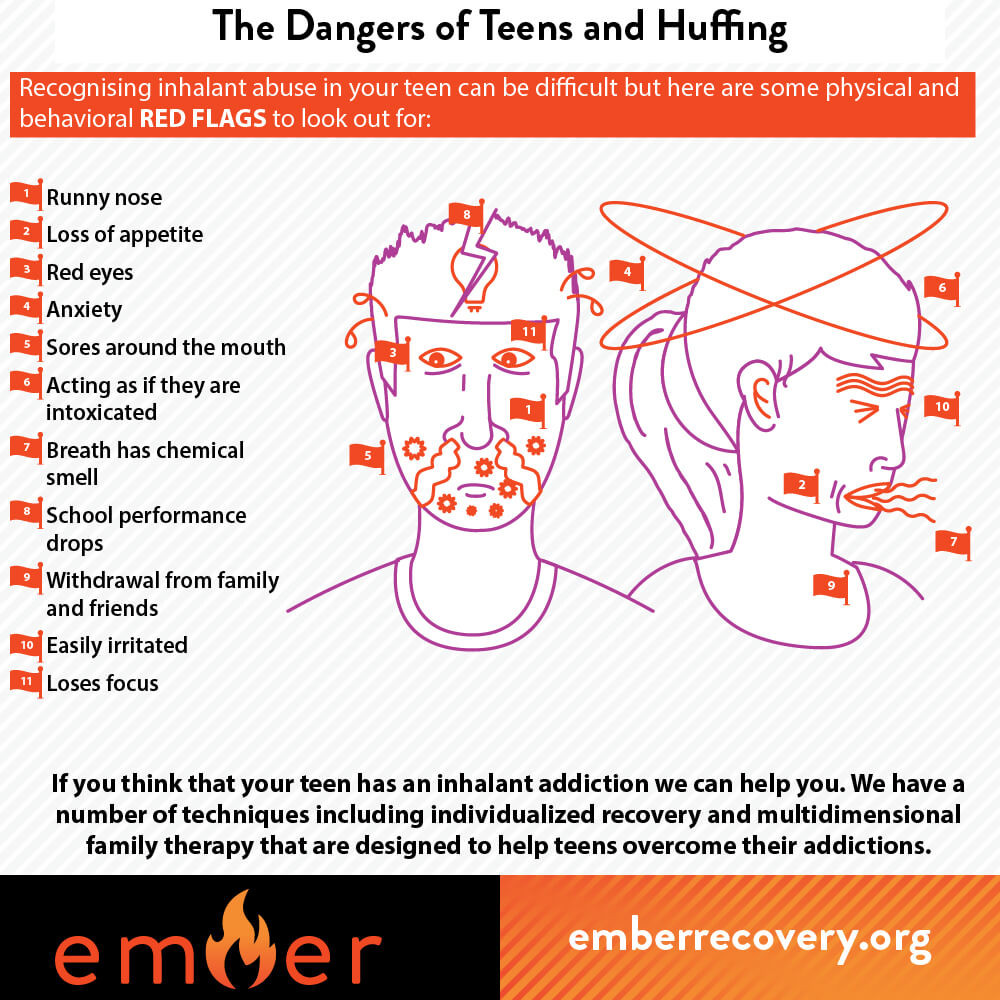Statistics show that more than 2.6 million children, ages 12-17, use an inhalant every year to get high.1 Inhalants tend to be the drug that children try first and are the fourth most-abused substance after alcohol, tobacco, and marijuana. What are the dangers of teens and huffing, and why are inhalants so popular?
Inhalant use, also known as huffing, has become popular among teens because it is an inexpensive way to get high. While many don’t realize the dangers of huffing, they can be just as serious as using other drugs. This is why recognizing the symptoms and seeking treatment is so vital.
As we take a closer look at the effects of inhalant use, we’ll also share some signs that your teen may be using inhalants and what you can do to help them.
What is Huffing?
Huffing is when people inhale fumes or vapors from different household products to get a quick high. Since the effects can be short-lived, people tend to repeat using them, leading to an inhalant addiction.
Items Used for Huffing
Many teens turn to huffing because there are so many different items that can be used, all easily accessible and inexpensive. 2
These include:
- Paint thinners or removers
- Gasoline
- Lighter Fluid
- Felt-Tip markers
- Glue
- Spray Paints
- Hair Spray or Deodorant Spray
- Aerosol Computer Cleaning Products
- Vegetable Oil Sprays
- Whipped Cream Aerosol Cans
- Room Deodorizer
People who use these inhalants breathe fumes in through their nose or mouth by snorting, huffing, or sniffing. Many people don’t think these items can cause danger. But they contain dangerous substances that can produce mind-altering effects when inhaled.
What are the Dangers of Huffing?
Huffing can cause serious health problems and damage to the body. Some dangers of huffing include long-lasting brain damage and damage to other parts of the nervous system. In some cases, nerve fibers in the brain and the peripheral nervous system can cause damage similar to the effects of multiple sclerosis.3
Inhalants can affect the central nervous system and slow down brain activity leading to slurred speech, lack of coordination, and euphoria. People using inhalants may also experience lightheadedness and hallucinations. This can eventually lead to headaches, drowsiness, and vomiting.
The effects of inhalants can also be seen in other organs. Chronic exposure can significantly damage the heart, lungs, liver, and kidneys, as well as bone marrow damage.
Inhalant abuse can also lead to death in various ways, such as:
- Suffocation
- Asphyxiation
- Convulsions and Seizures
- Choking
- Coma
Many people don’t realize they can overdose on inhalants. An overdose happens when someone uses too much of a drug and has a toxic reaction.2 Solvents and aerosol sprays are highly concentrated, containing many chemicals and active ingredients. Sniffing these products can cause the heart to stop in minutes, known as sudden sniffing death.
Chemical Hazards Found in Inhalants
Let’s take a closer look at how specific chemicals found in commonly abused inhalants can impact the body.3
- Benzene (found in gasoline) can lead to bone marrow injuries and an increased risk of leukemia.
- Amyl Nitrate (found in video head cleaner) can cause sudden sniffing death syndrome as it interferes with the oxygen supply to vital tissues.
- Butane and propane (found in hair sprays and paint sprays) can lead to sudden sniffing death syndrome and serious burns.
- Freon, which is used as a refrigerant and aerosol propellant, can cause liver damage.
- Toluene (found in gasoline and paint thinners) can lead to brain damage, limb spasms, and liver and kidney damage.
- Trichloroethylene (found in spot removers) can cause cirrhosis of the liver, as well as hearing and vision damage.
Teens and Huffing and What Parents Need to Look Out For
Realizing that your child is huffing can be difficult because the effects can be short-lived. Several signs can be red flags if you suspect your teen is huffing.
- Runny nose
- Loss of appetite
- Red eyes
- Anxiety
- Sores around the mouth
- Acting as if they are intoxicated
- Breath smells like chemicals
You may also notice that your child starts to do poorly in school and withdraws from family and friends. They can become irritated more easily and have trouble focusing. These can also be signs that your child is huffing.
If you notice any of the above symptoms, you’ll want to get your child help as quickly as possible. Inhalant addiction can become like any other drug addiction and requires a treatment program to stop. It’s important to act quickly because the dangers of huffing can lead to deadly consequences in some cases.
Seeking Teen Addiction Treatment at Ember Recovery
At Ember Recovery, we can help if your teen has an inhalant addiction. We specialize in treating all teen substance abuse and addiction, including inhalants. Our team understands that treating teens with an addiction differs from treating adults. This is why our programs are geared specifically toward teens and their needs.
We use a variety of techniques to help teens overcome their addictions. These include individualized recovery as well as multidimensional family therapy. We understand that each teen is different and that each treatment program needs to reflect that. Our team gets to understand your teen’s needs and develop a treatment plan to help them achieve success.
To learn more about how our programs can help your teen, reach out to us online or call us today.
Sources:
[1] https://www.consumered.org/programs/inhalant-abuse-prevention/data-research [2] https://nida.nih.gov/publications/drugfacts/inhalants [3] https://nida.nih.gov/publications/research-reports/inhalants/what-are-other-medical-consequences-inhalant-abuse
Andrea Dickerson is a Licensed Therapist and Certified Substance Use Counselor who has worked in behavioral health since 1997. Currently, Andrea is the Director of Behavioral Health, overseeing the Ember residential treatment programs and YSS outpatient counseling clinics throughout Central and North Central Iowa. She became a Motivational Interviewing (MI) trainer in 2006 and provides MI trainings throughout Iowa.
Andrea specializes in working with adolescents and their families and enjoys seeing the family relationships grow through therapy. Andrea is also a CARF International Surveyor, going around North America ensuring behavioral health organizations are meeting required standards.
In her free time, Andrea enjoys cheering on the Iowa Hawkeyes and Chicago Cubs, as well as being an active member of Soroptimist International of the Americas (SIA), a global organization that provides women and girls with access to the education and training they need to achieve economic empowerment. She has been a member of the SI of Des Moines club since 2012 and has been actively involved at the regional level, currently serving as Co-Governor of the Peaks to Plains Region.
Through her involvement in SIA, Andrea has been actively involved in the Dream Programs, coordinating annual Dream It, Be It: Career Support for Girls projects, which give girls the tools they need to achieve their education and career goals, empowering them to break cycles of poverty, violence, and abuse.





